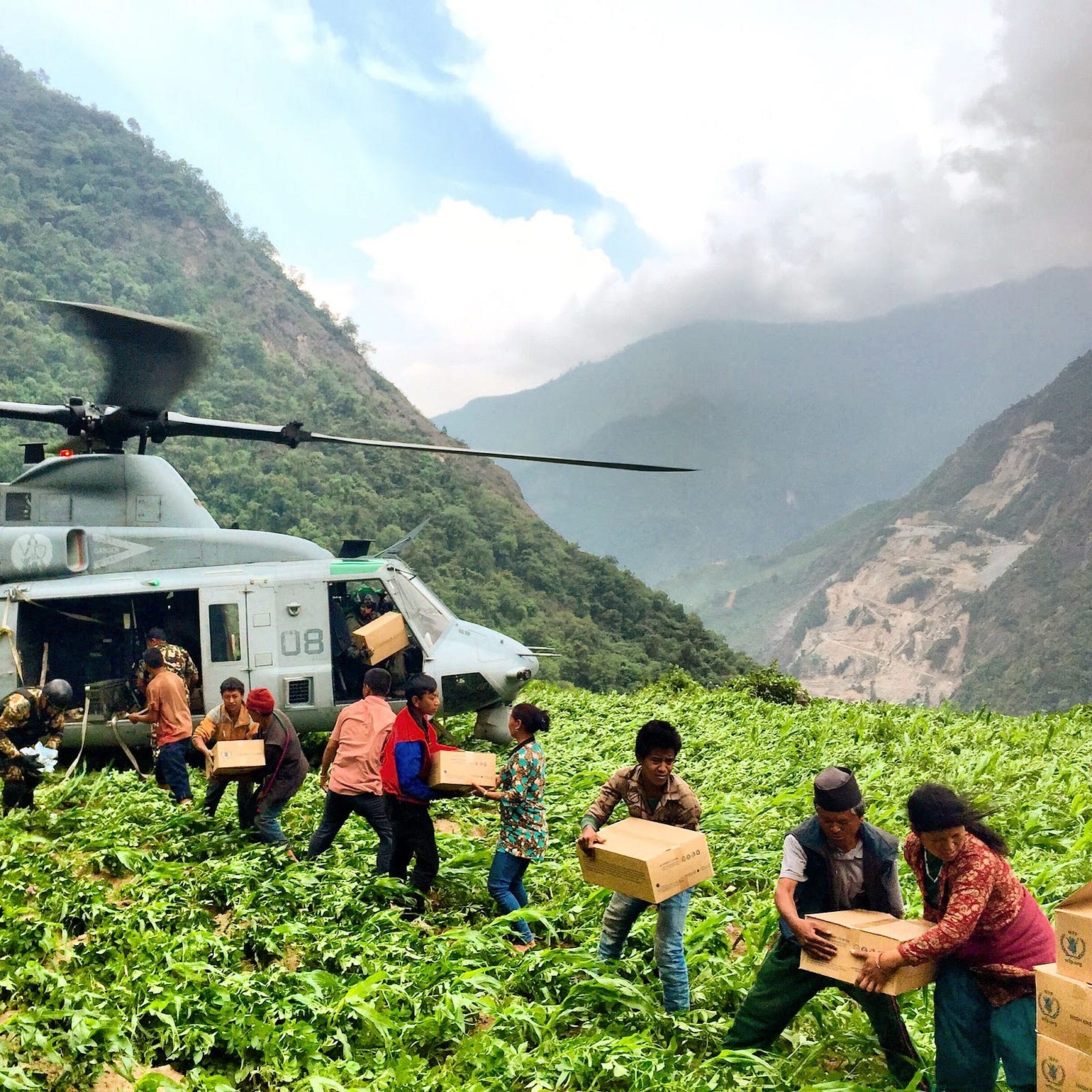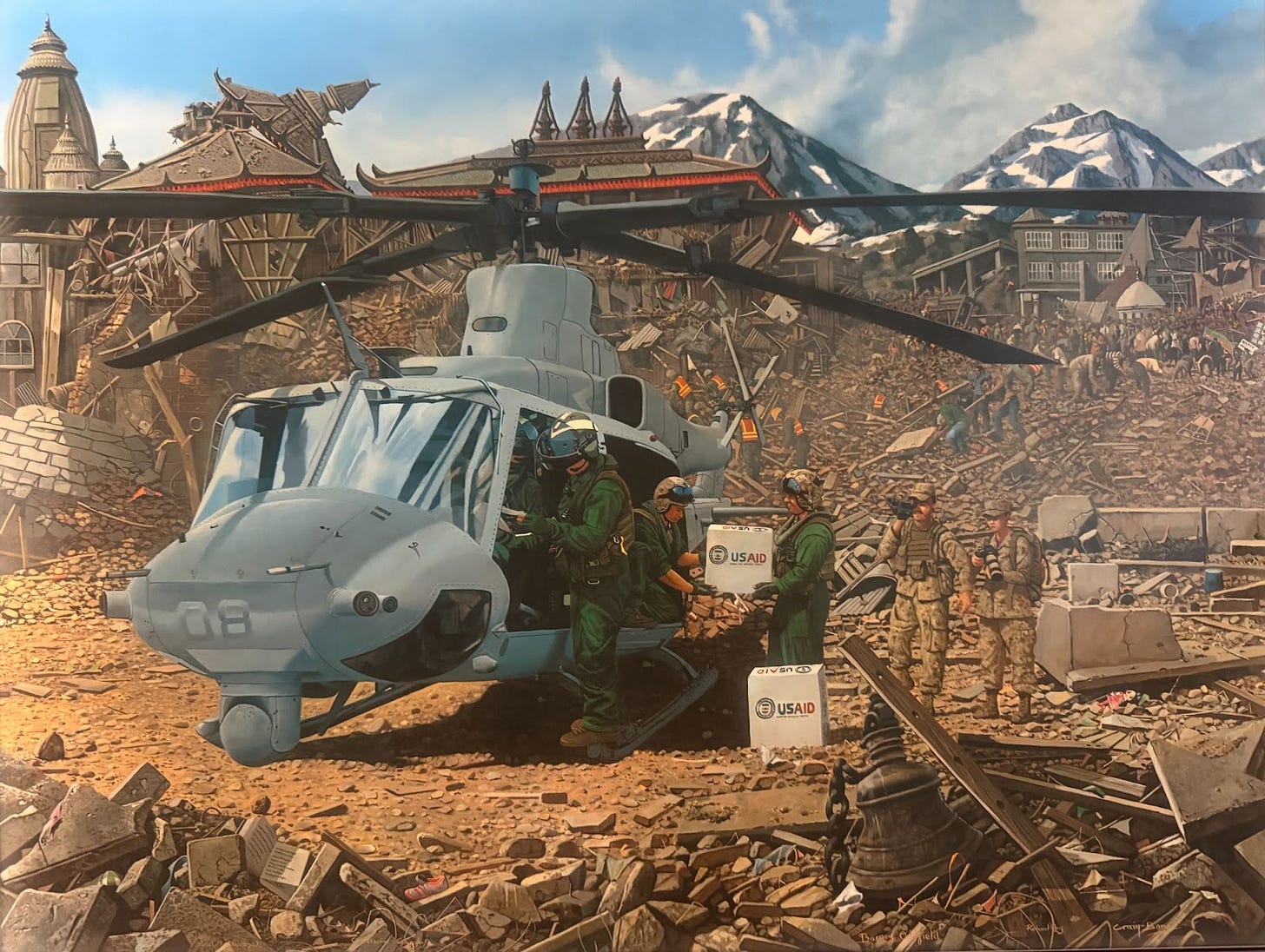On the 10-Year Anniversary of the Nepal Earthquake
A reflection on Nepal, Myanmar, and what America’s presence—or absence—means in moments of crisis
The earth shook for 55 seconds. That’s all it took to flatten entire villages, reduce ancient temples to dust, and sever lifelines to communities perched high in the Himalayas. In quiet mountain villages, parents clawed through rubble to reach their children. In Kathmandu, centuries-old towers crumbled as terrified crowds poured into the streets.
Halfway across the world, phones began to ring—at USAID’s Office of U.S. Foreign Disaster Assistance, at military bases, and across a web of humanitarian partners. The world was waking up to Nepal’s tragedy—and preparing to respond.
Not just a case study
The international response to the 7.8-magnitude earthquake in Nepal’s Gorkha District on April 25, 2015, isn’t just a case study in logistics or coordination. It’s a story about resilience, unlikely alliances, and what it means to show up for each other in our darkest moments.
At its heart, it’s about people: those who lost everything, those who rushed to help, and those who gave their lives trying.
The scale of the crisis
Nearly 9,000 people lost their lives. Over 22,000 were injured, and millions were displaced. In total, over 600,000 buildings collapsed, including homes, schools, and hospitals. Roads washed away under landslides, and critical infrastructure buckled.
The economic and social disruption was profound. In those early hours and days, one thing became clear: Nepal could not recover alone. It would take a global act of trust and solidarity to begin stitching the pieces back together.
The world responds

Within hours, USAID’s Office of U.S. Foreign Disaster Assistance (OFDA) stood up a Response Management Team (RMT) and deployed a 148-person Disaster Assistance Response Team (DART), including Urban Search and Rescue (USAR) teams from Fairfax County and Los Angeles County. Among others, USAID/OFDA coordinated closely with the Air Force, Marines, and Army Corps of Engineers while standing side-by-side with the people and government of Nepal, along with NGOs, the UN, and donors like India, China, and the United Kingdom.
This wasn’t just a rapid response—it was the result of years of investment in relationships and readiness, a coalition built on trust that enabled many different countries and organizations to act swiftly and effectively.

The moment I will never forget
In my decade-plus of international humanitarian work, I’ve seen my fair share. But one moment stands out more than any other.
A Marine helicopter, flying in the wind and rain, circled a remote mountaintop village in Nepal after the earthquake had erased the only road in or out. The helicopter searched for a safe location to deliver boxes of high-energy biscuits and emergency aid to families cut off by landslides.
What made that mission possible wasn’t just logistics—it was trust. It was coordination between USAID, the Department of Defense (DOD), an NGO, the Nepalese military, and a village teetering on the edge of survival. In that moment, the helicopter wasn’t just delivering aid—it was carrying the best of who we are and what we believe in as Americans: that when people are in need, we show up.
The price of showing up
A few days later, on May 12th, that same helicopter crashed. While running another remote mission, a major 7.3 aftershock struck. The humanitarian community reverted back into response mode, making Vengeance 01 a first responder.
The DOD reported:
“On their chosen route of return to Kathmandu, which may have been made because one or more of the injured was in need of urgent treatment, a Marine UH-1Y Huey helicopter aircraft, call sign 'Vengeance 01,' was enveloped by rapidly developing clouds or lifted into a cloud by rising air currents. As they attempted to maneuver out of the weather conditions, they lost visual reference with the terrain and impacted the ground."
Thirteen lives were lost on that mission, including five injured civilians, two Nepalese soldiers, and six U.S. Marines:
Capt. Dustin R. Lukasiewicz
Capt. Christopher L. Norgren
Sgt. Ward M. Johnson IV
Sgt. Eric M. Seaman
Cpl. Sara A. Medina
Lance Cpl. Jacob A. Hug
Their sacrifice is a stark reminder of what it means to show up—not just when it’s convenient or safe, but in service to the principles that define us: compassion, solidarity, and the quiet conviction that helping one another is the right thing to do.
Long-term commitments
In total, USAID allocated over $130 million for response and recovery efforts. That included USAR teams, relief supplies, food assistance, and shelter infrastructure. USAID also supported health, water, sanitation, and hygiene (WASH), education, protection, longer-term recovery, and disaster preparedness.
During this crisis, USAID worked closely with Nepal’s government, NGOs, and international organizations to ensure effective response and recovery by training engineers and construction workers in earthquake-resistant building techniques. We supported community-based disaster risk reduction programs and funded early warning systems and preparedness training for future disasters.
The U.S. relationship with Nepal remains strong, in large part because we showed up during their greatest moment of need.
What happens when we don’t?
That’s why, when a 7.7-magnitude quake rocked Myanmar in March, I felt a familiar knot in my chest.
Once again, families searched for loved ones, and more villages were isolated. But this time, there was no surge of coordination in the U.S., no deployment of USAR or interagency partners, no urgent calls from the Ops Center.
Because this time, we couldn’t respond the way the people of Myanmar needed.
Instead of a full DART team, a team of three was sent. There were no aid airlifts, no American military helicopters hovering over cut-off communities, no forward-leaning posture that once defined America’s humanitarian reach.
In the vacuum, others stepped in. Instead of American expertise, this response was defined by aid and rescue personnel from, among others, China and Russia. In a moment of profound suffering, these were the countries that shaped how Myanmar, and the wider world, understand who shows up.
A decade earlier, the U.S. helped write a different story during the Nepal earthquake. We didn’t just save lives–we earned trust.
By now, in Myanmar, that story is being written without us. Because the same week as the Myanmar earthquake, the Trump administration fired the USAID staff in charge of disaster response.
More than just aid supplies
When the U.S. steps back, it’s not just funding that disappears. It’s the trust, the coordination, the capacity to act quickly and humanely. It’s the ripple effect of what happens when we show up—or when we don’t.
Ten years ago, the American people provided a singular example of their goodwill and courage. I hope that, when the next disaster strikes, we will again be ready—not only with resources, but with humility, respect, and the fierce belief that people matter.
Even across oceans. Even across fault lines.
About the author
Warren Acuncius started his USAID career as a development intern in 2007 and spent another 12 years with OFDA and BHA, supporting 25+ disaster responses like West Africa Ebola, Lebanon Port Explosions, and the Russian invasion of Ukraine.
He is an associate professor at the University of Washington, was a Johns Hopkins Emerging Leader in Biosecurity Fellow, and was a featured speaker at the US Air Force Academy’s 2024 National Character & Leadership Symposium.








Very sad that America, for all its greatnesses, could only send 3 people in March 25.
In the name of saving money, the US is hurting folks on the other side of the world.
I hang my head in sadness and humiliation.
I don't our current “President” has ever felt humiliated.
Truly the best of America and now Trump and Musk have killed it so they can grift America without him worrying about accountability